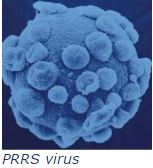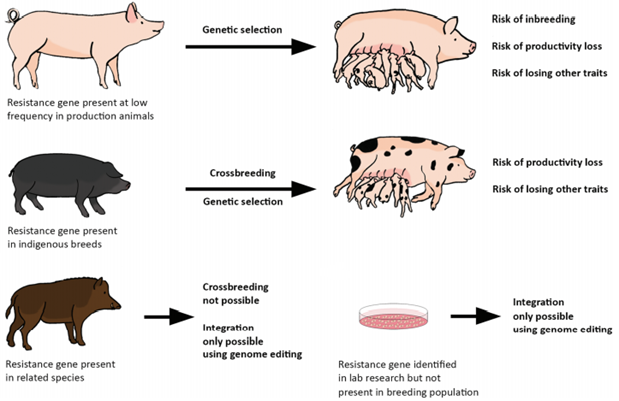



Strategies towards the eradication of PRRS
Porcine reproductive and respiratory syndrome (PRRS) has adversely impacted the global pig industry for decades. Recent studies review some interesting strategies that are vital towards the eradication of PRRS.PRRS is characterised by abortion, premature birth, and high piglet mortality in sows, as well as pneumonia and mortality in weaned piglets and meat pigs. Limited understanding of the virology, and evolution of PRRS virus and the host's immune response, impedes the development of effective methods to eradicate the virus. What aggravates the complexity behind the elimination of PRRS in the pig industry is the continual emergence of new mutants seen during most outbreaks.
Antiviral strategies against PRRS virus infection
Researchers from the Northwest A&F University in Xianyang, China recently published, in the journal Trends in Microbiology, several antiviral strategies against PRRSV infection. These strategies may provide creative insights to guide future PRRS control and prevention.

RNA-based strategy, chemical compounds, and nanobodies
The authors report that antisense-based (targeting the mRNA) strategies including small interfering RNAs (siRNAs), short-hairpin RNAs (shRNAs), artificial microRNAs, and PMOs (morpholino oligomers) are effective in the inhibition of PRRSV infection both in vitro and in vivo, through suppression of PRRSV replication. In their study they also discovered that chemical compounds, such as tetrahydroaltersolanol C, N-acetylpenicillamine and dipotassium glycyrrhetate inhibit PRRSV replication in vitro. One major drawback noted for these compounds is their non-specificity nature since they appear to inhibit replication of multiple diverse viruses – with unclear mechanism of their antiviral activity. Nanobodies (single-chain antibody fragments), like whole antibodies, have binding specificity to several viruses and act in unique ways due to their small size, ease of genetic manipulation, high specificity, and solubility. They hold great potential for development as novel antiviral treatments for PRRSV infection.
Potential of immune stimulators as adjuvants
Another strategy posed by the researchers entails activating the innate immune response using Toll-like receptor (TLR) agonists – several of which inhibit PRRSV replication.
“Since activation of TLRs leads to induction of IFNs (interferon) and other cytokines, IFNs are worth testing for their anti-PRRSV activity, or adjuvant potential. Studies show that pre-treatment of pigs with IFN-α prior to challenge eases PRRSV-induced symptoms,” said the researchers.
PRRSV neutralizing targets and implications for future PRRSV vaccines
The researchers also said, “Although antibody responses during PRRSV infection were initially viewed as a deleterious and ineffective component of PRRSV-specific immunity, neutralizing antibodies are now considered to be essential to combat PRRSV. This is seen in experimental infection whereby the onset of neutralizing antibody is accompanied by virus clearance. However, if neutralizing antibodies could be further characterized, this information could promote development of a cross-protective vaccine against heterogeneous PRRSV strains.”
Potential of plant extracts
In another recent study, published in Journal of Animal Science and Biotechnology, researchers from the University of California in Davis, USA found that plant extracts of capsicum, garlic and turmeric regulate gene expression of alveolar macrophages of PRRSV-infected pigs, especially altering genes involved in immunity.
Their results clearly showed that PRRS infection up-regulates the expression of genes related to cell apoptosis, immune system process, and response to stimulus, while down regulating the expression of genes involved in signalling transduction and innate immune response. The three plant extracts (supplemented in three diets at 10 mg per kg of feed each) differently regulated the expression of genes related to the innate immune responses in alveolar macrophages of PRRSV-infected pigs but all counteracting the effects of PRRS on gene expression.
“The changes in the expression of immune-related genes may help us understand the mechanisms through which plant extracts strengthen immune responses of PRRS-infected pigs,” concluded the researchers.
Is genome editing the future?
In 2020, researchers from the University of Edinburgh in Midlothian, UK carried out a study to identify factors and benefits to consider for genome editing to fit within existing selective breeding structures. They also put their thoughts on which factors, or challenges are vital for implementation of this technology. Their study is found in Animal Frontiers.
The following are factors and benefits of genome editing the researchers found:
- “When a resistant gene is present at low frequency in production animals, genetic selection poses a risk of inbreeding, and loss of productivity. In such circumstances, genome editing allows the direct introgression of a beneficial allele into the offspring of diverse, highly productive animals.
- Similarly, in circumstances where resistance or resilience is observed in a related species, crossbreeding is simply not an option as it presents risk of productivity set-back. However, genetic comparison can be used to identify the functional differences underlying such traits, and genome editing employed to introduce appropriate variants into the desired species.
- With a good understanding of host–pathogen interactions, novel genetics that has not been observed in live animals can be created and tested for efficacy in a laboratory environment, and again, genome editing presents a practical route to benefit from such findings.
- A second measure worth consideration before embarking on an editing project is whether the gene is located within a locus that has been actively selected in breeding programs. This could indicate whether a potential target is associated with known production traits.”

© Source: Frontiers in Veterinary Science
The researchers think consumer acceptance and the regulatory framework could present major challenges for implementation of this technology. Approval of legislation for edited animals for human consumption requires a holistic approach (that might bring complexity) since the application of GM animal techniques in livestock is affected by several factors including the consumer and producers’ acceptance, public policies, human health, animal welfare, environmental impact, and sustainability.
“Overall, genome editing allows us to overcome bottlenecks in trait-selective breeding and allows the incorporation of genetic traits from other breeds, related species, or laboratory results. In addition, technical improvements in the generation of genome edited animals will reduce the cost implications of this technology,” the researchers said.
Economic effects of vaccination
With the current efforts in the development of vaccines, surely, the economic effects of vaccination against PRRS are interesting. In their recent study, the researchers from University of Bern in Bern, Switzerland (Published in Frontiers in Veterinary Science) investigated the economic impact of potential new PRRS vaccines with improved efficacy. Two different vaccination strategies were considered in the model: (i) mass vaccination of sows only (MS) and (ii) mass vaccination of sows and piglets (MSP). For MS, the vaccination protocol comprised a basic immunization of all sows and a booster vaccination 4 weeks later, then every 3 months. Incoming gilts were vaccinated twice during acclimatization. The MSP strategy followed the same protocol as the MS but with additional vaccination of piglets between the ages of 2–3 weeks.

© Source: Frontiers in Veterinary Science
The researchers found that vaccinating both sows and piglets proved to be more profitable than vaccinating sows alone. On the other hand, the magnitude of benefits derived from vaccination was more sensitive to changes in vaccine effectiveness than to vaccine price changes.
“The additional cost for the piglet vaccination was compensated and surpassed by the improved production performance in the nursery and fattening stage. Among other possible factors, the ‘vaccine cost-benefit ratio’ could be a key criterion in farmer’s decision-making process,” they concluded.







